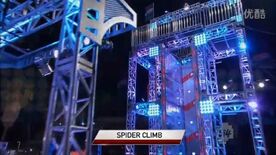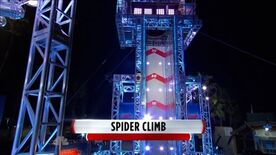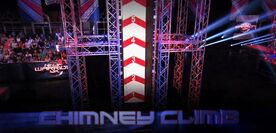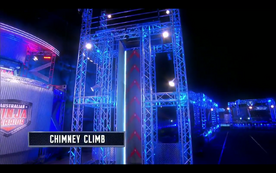The Spider Climb (スパイダークライム) is an obstacle, firstly introduced as the first obstacle in the Final Stage of SASUKE 5. The basic concept is that competitors must climb two parallel walls in a similar fashion to the Spider Walk, except competitors must move upward rather than forward. Throughout the numerous tournaments the obstacle has been in SASUKE, it has gone through three versions.
Version 1 (SASUKE 5-17)
The first version of the obstacle was 12 meters in height, though it was stated to be 12.5 meters in height during the broadcast. The extra 0.5 meters came from a gap between the 10-meters high Tsuna Nobori. If the Spider Climb wasn't completed in 15 seconds, the walls would start to move apart, making it harder to climb and eventually impossible to complete the obstacle. Only two competitors failed on this obstacle:
- Yamamoto Shingo in SASUKE 7, when his shoulder was suddenly dislocated, shortly after starting the obstacle, and
- Jordan Jovtchev in SASUKE 8, when he failed to complete the obstacle within 15 seconds, resulting in the walls splitted apart, with him unable to finish the obstacle before they split completely.
The time limit to complete the Final Stage was still 30 seconds when the Spider Climb was added, resulting in the second version of the Final Stage being much tougher than its predecessor; the 15-meter high Tsuna Nobori. After Nagano Makoto's kanzenseiha in SASUKE 17, the Spider Climb was replaced by the Heavenly Ladder.
Version 2 (SASUKE 29-31)
In SASUKE 29, the Spider Climb returned as the first obstacle in the Final Stage. While looking similar to the first version aesthetically speaking, this version of the Spider Climb had two differences from the original:
- The 0.5-meter gap between the Spider Climb and Tsuna Nobori was removed, officially making the obstacle 12 meters in height, despite the fact that the physical height of the obstacle went unchanged.
- The walls would no longer split after 15 seconds. Instead, the walls remained stationary throughout the 30-second time limit.
This version of the Spider Climb did not last as long as its predecessor, being attempted in only 2 tournaments before Morimoto Yūsuke's kanzenseiha in SASUKE 31.
Version 3 (SASUKE 32-)
For the course redesign in SASUKE 32, the Spider Climb was retained, but was modified yet again. This current version of the obstacle was only 8 meters in height, and unlike the previous two versions which led to the Tsuna Nobori, this version led directly into a 7-meter high Salmon Ladder, which in turn led directly to the 10-meter high Tsuna Nobori.
In the first three tournaments, due to the difficulty of the Third Stage, this version of the Spider Climb (along with the Final Stage) was unattempted. However, in SASUKE 35, the obstacle was attempted for the first time by Morimoto Yūsuke.
KUNOICHI Version
Due to Izumi Hikari's close kanzenseiha in KUNOICHI 9, for the very first time, the Spider Climb made an introduction in KUNOICHI 10, replacing the Sayu Hashigo from KUNOICHI 9, with its height was the same as the current version from SASUKE 32 onward.
However, in KUNOICHI 11, the obstacle's height was increased to 10 meters for unknown reason.
American Ninja Warrior Appearances

American Ninja Warrior 5's Spider Climb

American Ninja Warrior 6's Spider Climb
On American Ninja Warrior 5 and American Ninja Warrior 6, the Spider Climb appeared as the tenth and final obstacle in every city finals course, replacing the Cargo Climb/Cargo Net from the past four American Ninja Warrior seasons, with the walls' height being 30 feet (9.14m) and the distance between the walls being 4 feet apart (1.3m).
Since the competitors attempted the obstacle without wearing safety gears (unlike in SASUKE and all of SASUKE/Ninja Warrior's international formats, where competitors must wear safety gears before attempting the Final Stage/Mount Midoriyama tower), the starting platform at the bottom of the walls would move slightly upward when the competitors scaled the obstacle, in order to soften the impact, in case of the competitors failed to complete the obstacle and fell.
During its overall appearances, the obstacle was proven to be very easy, as only a handful of competitors failed on this obstacle, including James Sclar (during American Ninja Warrior 5's Venice Beach finals, dislocating his shoulder in the process) and Dustin McKinney (during American Ninja Warrior 6's Miami finals).
On American Ninja Warrior 7, it was replaced by a far more brutal obstacle, the Invisible Ladder. Later, a similar obstacle (called as the Spider Trap) appeared as the tenth and final obstacle in every city finals course on American Ninja Warrior 10.
Other Appearances

Ninja Warrior UK 3's Chimney Climb

Australian Ninja Warrior's Chimney Climb
On several Ninja Warrior's international formats (e.g. Ninja Warrior UK and Australian Ninja Warrior), the Spider Climb usually appeared as the final obstacle during the semifinals and finals' Stage 1, and was called as the Chimney Climb.
Competitors' Success Rate
- All results based on the TBS broadcast and external information found
| SASUKE | Clears | Attempts | Percentage |
|---|---|---|---|
| 5 | 0 | 0 | N/A |
| 6 | 0 | 0 | N/A |
| 7 | 0 | 1 | 0% |
| 8 | 1 | 2 | 50% |
| 9 | 0 | 0 | N/A |
| 10 | 0 | 0 | N/A |
| 11 | 1 | 1 | 100% |
| 12 | 3 | 3 | 100% |
| 13 | 1 | 1 | 100% |
| 14 | 0 | 0 | N/A |
| 15 | 0 | 0 | N/A |
| 16 | 0 | 0 | N/A |
| 17 | 2 | 2 | 100% |
| 29 | 0 | 0 | N/A |
| 30 | 2 | 2 | 100% |
| 31 | 1 | 1 | 100% |
| 32 | 0 | 0 | N/A |
| 33 | 0 | 0 | N/A |
| 34 | 0 | 0 | N/A |
| 35 | 1 | 1 | 100% |
| Total | 12 | 14 | 85.71% |
